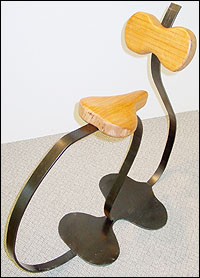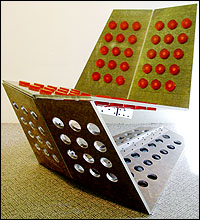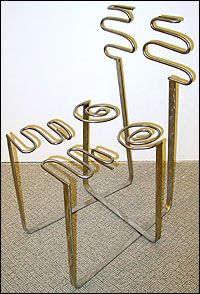Archives
Architecture students offer unique views of the humble chair
By SUE WUETCHER
Reporter Editor
The chair. Many of us view this humble device simply as a means—sometimes comfortable, sometimes not—to "take a load off."

Drafting Chair, Keegan Roberts
PHOTOS: DONNA LONGENECKER
But for architecture students who completed the seating design assignment in Abir Mullick's "Senior Studio" (ARC 404/504) this past spring, the chair became something more; it became, according the course description, "a complex, everyday object" requiring "critical attention to function, structure, material and economics."
The purpose of the seating design assignment, says Mullick, associate professor of architecture in the School of Architecture and Planning, was to examine the idea of seating from a wide range of social, technological and utilitarian perspectives, and study seating design from the perspective of how it "celebrates the human body." Students were asked to study the chair as an object influenced by technique, style and status, he says, and think creatively about its design, construction and usability in order to understand the "near environment" that touches the body.

Aluminum Pop, Jose Chang
Mullick points out that because present ideas about seating evolved in the past, understanding today's seating designs requires appreciation of cultural history—both old and new. And when comparing chairs among various cultures, he says, it becomes evident that they "are truly cultural artifacts, not simply extensions of our bodies."
The chief objective of the course, according to the syllabus, was for students to design and build a seat that "highlights ergonomic interest and creative design."

Minimal Metal, Casey Milbrand
The seats had to show a "creative solution" to sitting; be able to be used by a range of persons; be easy to get in and out of, and help the "sitter" maintain comfortable posture; demonstrate efficient use of material, construction and technology, and be constructed at full-scale.
Among the chairs that were designed and built for the course:
"Drafting Chair" by Keegan Roberts. Roberts' drafting chair offers chest support not found in other drafting chairs, Mullick says. "Since people need to lean forward when drafting, a chest support helps to maintain stable posture and it offers good body support. The seat position and chest support are adjustable and they can be adjusted many body sizes."
"Aluminum Pop" by Jose Chang. "Jose's chair studied cantilever design for support and stability," Mullick explains. "The chair, which is constructed out of aluminum sheet and supported on a central metal bracket, is unusually strong. It is comfortable to sit and allows body movement. Jose has installed rubber cups on the seat and back surfaces to prevent the body from coming in contact with the metal surface."
"Minimal Metal" by Casey Milbrand. "Casey studied the need for body support and he designed a chair to provide minimal support," Mullick says. "Four pieces of seat structure and two pieces of back structure are supported independently of the other. This helps body movement and allows maintaining posture, independent of individual structure."
The chairs may be viewed in the Dyett Gallery in Hayes Hall, South Campus, from 9 a.m. to 5 p.m., Monday through Friday.
